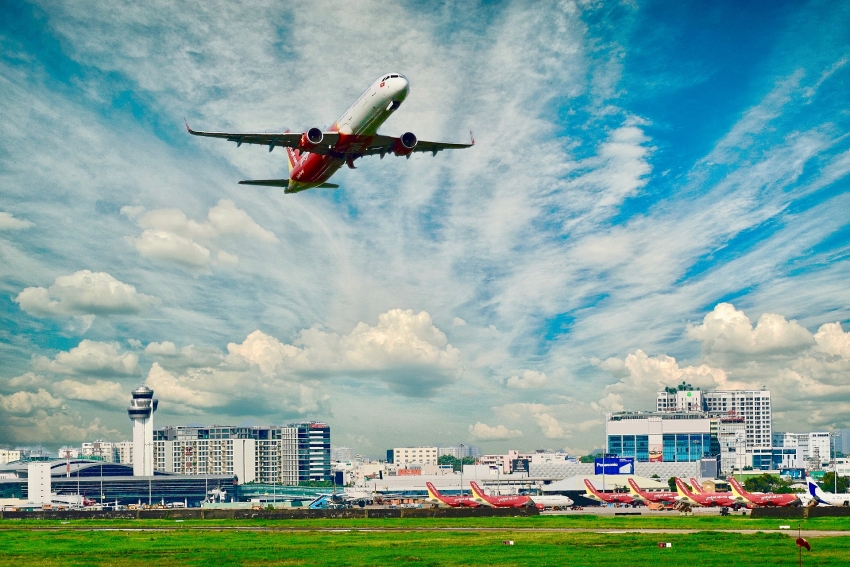Vietjet revenue and profit surge on back of key markets like India
 |
| Vietjet boasts rosy performance in 2019 in its fourth-quarter report |
Vietjet Aviation JSC (HoSE: VJC) has announced its business results for 2019’s fourth quarter. Accordingly, the airline’s air transportation revenue in the fourth quarter stood at VND10.5 trillion ($465.52 million), an increase of 25 per cent.
Full-year 2019 revenue and profit from air transportation stand at VND41.097 trillion ($1.79 billion) and VND3.936 trillion ($171.13 million), increasing by 21.4 and 29.3 per cent, respectively, compared to 2018. Vietjet’s revenue from sales and leaseback activities has been adjusted due to the airline’s revising its aircraft delivery from Airbus in 2019.
The airline received 16 aircraft in 2018 while the number for 2019 was 7, which brought Vietjet’s accumulated revenue and profit in 2019 to VND52.095 billion ($2.27 billion) and VND5.01 trillion ($217.83 million), respectively, a slight decrease compared to 2018.
To compensate for the delay in new aircraft delivery from Airbus, Vietjet carried out a lease of nine aircraft, increasing its operating fleet to 78 aircraft with 321,000 aircraft operation hours and 139,000 flights. Its load factor stays at 87 per cent, with technical reliability rate being at 99.64 per cent, which are among the top airlines in the Asia-Pacific region. Vietjet has also been awarded the highest ranking for safety with seven stars from AirlineRatings.com.
The carrier’s growing business is also attributed to its effective strategies on ancillary revenue management, including extra service fees, cargo transportation, inflight services (food, beverages, and duty-free items) and advertisements. In 2019, Vietjet’s ancillary revenue was VND11.356 trillion ($493.74 million), up 35.2 per cent compared to 2018. The portion of ancillary revenue in the airline’s total air transportation revenue also increased from 25.4 per cent in 2018 to 30 per cent in 2019.
Following the sustainability-focused model of low-cost carrier (LCC), ancillary revenue has become an important factor determining the success of Vietjet because of its profit margin exceeding 90 per cent. According to the CarTrawler Yearbook 2019, Vietjet ranked 12th worldwide in terms of its ratio for ancillary revenue on top of total air transport revenue.
According to Vietjet’s consolidated financial report, the airline’s total assets in 2019 were VND47.608 trillion ($2.07 billion) with the owner’s equity of VND17.661 trillion ($767.87 million) including VND2.347 trillion ($102.04 million) of treasury shares, increases of 22 and 25.8 per cent, respectively, against 2018.
Its current liquidity is 1.4. Cash assets were VND6.076 trillion ($264.17 million), not including VND2.347 trillion ($102 million) of treasury shares, cash in total reached VND8.423 trillion ($366.22 million). While the debt to equity ratio was 0.77, the lowest rate in Vietnam’s aviation industry. Vietjet’s EBITDAR margin was 31 per cent, ranking as one of the top airlines in the world.
Vietjet’s new and modern fleet also became younger with the average age of 2.75 years, with great fuel-efficiency. Especially, in September 2019, the airline received an A321neo ACF (Airbus Cabin Flex) aircraft with 240 seats, the first of its kind in the world. The new aircraft features fuel consumption savings by a minimum of 16 per cent; noise reduction up to 75 per cent; and emission reduction up to 50 per cent.
In 2020, the airline plans to take delivery of nine more new A321neo aircraft and 20 more every year from 2021, which is expected to reduce fleet operation costs and increase the profit from air transportation and aircraft financing activities. Additionally, Vietjet continues to optimise its operation and management costs in order to enhance its air transportation business performance.
What the stars mean:
★ Poor ★ ★ Promising ★★★ Good ★★★★ Very good ★★★★★ Exceptional
Related Contents
Latest News
More News
- Vietjet launches daily Manila flights to celebrate year-end festive peak season (December 05, 2025 | 13:47)
- The destinations powering Vietnam’s festive season travel demand (December 04, 2025 | 18:33)
- Vietnam named among the world’s most exciting winter destinations (December 04, 2025 | 15:10)
- Phu Tho emerges as northern Vietnam’s new tourism hub (December 01, 2025 | 17:00)
- Vietjet completes Airbus A320/A321 updates ahead of deadline (December 01, 2025 | 09:49)
- Vietjet resumes Con Dao flights from early December (November 28, 2025 | 15:24)
- Free tickets, Lunar New Year promotions on offer at Vietjet Mega Livestream (November 26, 2025 | 15:32)
- Scandinavian Airlines and Vietnam Airlines broaden agreement with new routes (November 25, 2025 | 17:04)
- Halong Cruise Port welcomes over 3,100 international visitors (November 12, 2025 | 18:06)
- Vietnam.travel climbs to second place in Southeast Asia website rankings (November 12, 2025 | 18:01)

 Tag:
Tag:

























 Mobile Version
Mobile Version